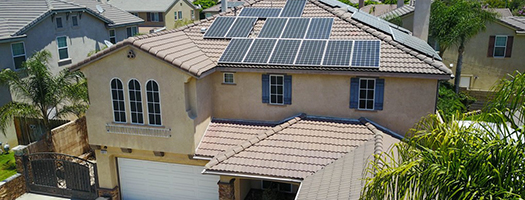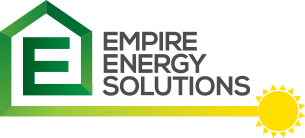Financing a residential solar energy system actually costs less than purchasing electricity from a customer’s local utility. Studies show the cost of going solar has dropped every year since 2009. If you’d like to purchase your solar energy system, you don’t have to buy it in cash — there are a number of different financing options, most of which do not require any initial investment to install.

Solar Myths
You can’t save money by going solar.
Solar brings great potential to save money on your monthly utility bill. The amount you save depends upon how much electricity you consume, the size of your solar energy system, and how much power it is able to generate. The monthly amount owed on a solar loan is typically less than an average utility bill. With utility bills trending upward, solar is likely to remain a good money-saving option for years to come.
You need to own a house to go solar.
Do you rent your house? Or do you live in a high-rise condo building? Do you live in a Luxury Apartment Complex? Do you rent a space in a shopping center? Not a problem. Community programs allow multiple people to benefit from a single, shared solar array. These arrays can be installed on your building, parking lot or offsite in a different location. Purchasing costs and the installation of the solar energy system are then divided among all of the participants. All are then able to buy into the shared system at a level that best fits their budget. The portion you share can even be negotiated into the sale of your home should you move!
Solar will lower the value of your home.
Quite the contrary – buying a solar energy system will likely increase your home’s value. Studies have found that solar panels are viewed as upgrades, just like a renovated kitchen or a finished basement, and home buyers across the country have been willing to pay a premium of about $15,000 for a home with an average-sized solar array. The real estate market is beginning to embrace solar, making it vital that real estate agents, appraisers, and homeowners increase their solar knowledge and leverage the premium-boosting power of a solar system to sell or refinance their homes.
Solar doesn’t work in certain climates or areas.
Solar panels only need one thing to generate electricity, sunshine! Even in the winter when there are fewer hours of daylight, there is still a sufficient amount to power the average American home. That makes solar viable even in Alaska with longer, colder winters. System peak in performance, typically in the spring to the end of summer due to increased daylight. But, there is usually an increased usage due to increased air-conditioner use and pool equipment. Conversely, there is lower use of electric energy in the winter with cooler to cold weather and use of gas heating.

Solar Glossary of Terms
AC POWER
AC is short for alternating current and is the usual way by which electricity is delivered to residential and industrial locations. With the use of higher voltage, the transmission of power becomes significantly efficient.
AMP
Also known as ampere, it is a unit of electric current or amount of electric charge per unit time in coulombs per second. In a practical household wiring terms, it is the measurement of the number of electrons passing through a given point in one-second intervals.
DC POWER
Short for direct current, it is the unidirectional flow of electric charge. Direct current is produced by such sources as batteries, thermocouples, and solar cells. In direct current, the electric charges flow in a constant direction.
ELECTRICAL LOAD
An electric circuit connected to an output terminal. Electrical load affects the performance of circuits that output voltages or currents. A power outlet is an example of voltage source, outputting 120 VAC (volts alternating current).
ELECTRICAL PANEL
A component of an electricity supply system which divides an electrical power feed into subsidiary circuits, while providing a protective fuse or circuit breaker for each circuit in a common enclosure. This device is also most commonly known as a breaker panel, fuse box or load center.
INVERTER
An electrical device which is designed to convert direct current (DC) into alternating current (AC). The resulting AC can be at any required voltage or frequency. It is so named because early mechanical AC to DC converters were made to work in reverse order and thus were “inverted” to convert DC to AC. The inverter performs the opposite function of a rectifier.
KILOWATTS
1,000 watts = 1 kW (kilowatt). It is used to state the power output of engines and the power consumption of tools and machines. A kilowatt is approximately equivalent to 1.34 horsepower. An electric heater with one heating element might use 1 kilowatt.
PHOTOVOLTAIC
Photo – meaning light and voltaic – referring to electricity. Photons sent from the sun are absorbed by the panels and converted to electricity.
SOLAR CELLS
A device that converts solar energy into electricity by the photovoltaic effect. Assemblies of cells are used to make solar panels, solar modules, or photovoltaic arrays. These cells convert the photons sent from the sun into electrons, leading to the production of electricity.
SOLAR PANELS
A photovoltaic (electrons are emitted form matter after the absorption of energy from electromagnetic radiation such as x-rays or visible light) device that turns the energy of the sun into electricity.
TIME OF USE
If the utility charges consumers more during a specific season and time of day, they are by law required to credit the same rates to individuals that are generating electricity through solar panels. Customers will be credited accordingly in line with utility’s pricing.
UTILITY GRID
Electrical power transmission is the bulk transfer of electrical power. A power transmission network typically connects power plants to multiple substations near populated areas.
UTILITY METER
Metering device used to measure the units of electricity, gas, and water. In this case, it is most commonly known as an electric meter that measures the amount of electrical energy supplied to or produced by a residence, business, or a specific machine.
VOLTAGE
The difference of electrical potential between two points of an electrical or electronic circuit expressed in volts. It is the measurement of the potential for an electric field to cause an electric current in an electrical conductor.
WATTS
Watts are units of power. It measures a rate of energy conversion. A typical household incandescent light bulb uses electrical energy at a rate of 25 to 100 watts.

